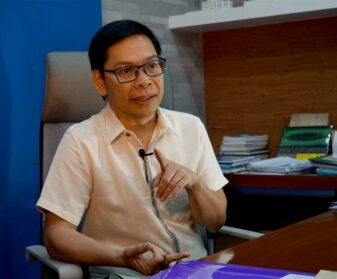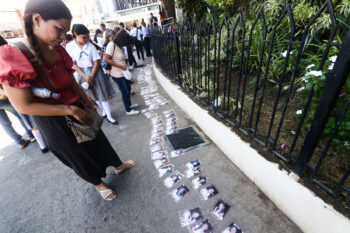2nd of a six-part series
(*This six part series is based on an article I wrote with Atty. Janice Lee entitled “The Draft Bangsamoro Basic Law: Overcoming Constitutional Challenges” which Ateneo de Davao University just published in a Compendium on the Draft Bangsamoro Basic Law).
(CAGAYAN DE ORO CITY (MindaNews/11 March) — One of the biggest potential hurdles for the draft Bangsamoro Basic Law BBL) is the extent of the political autonomy that will be granted to the Bangsamoro. The draft law outlines the powers that are to be exercised concurrently by the Central Government (CG) and the Bangsamoro Government (BG), those that are reserved for the CG, and those that are exclusive to the BG. The main challenge under this area is the contention that the draft BBL (as well as the CAB) establishes a separate independent state (the Bangsamoro) within the Philippines.
Under Philippine law, the creation of autonomous regions does not signify the establishment of a sovereignty distinct from that of the Republic, as it can be installed only within the framework of the Constitution and the national sovereignty as well as territorial integrity of the Republic of the Philippines.
To begin with, there is no universal standard framework that governs the delineation of powers and functions between autonomous regions and the host state. In many states, the degree and extent to which certain powers are granted to the autonomous region is a matter of policy – whether to grant the region substantial self-sufficiency (e.g. Scotland, Greenland), or to severely limit the autonomy of the territory (e.g. Tibet, Navajo).
In order to address the contention of whether the BBL establishes a separate state, however, one framework which may be referred to is the traditional definition of a state. Under the Montevideo Convention, the state as a person of international law should possess the following qualifications: a) a permanent population; b) a defined territory; c) government; and d) capacity to enter into relations with other states. In this regard, the BBL, while establishing the first three elements, does not endow the BG with the capacity to enter into relations with other states. In fact, foreign policy remains under the reserved powers of the CG under Article V, Section 1 of the BBL. The BG’s exclusive powers, as provided under the draft BBL, pertain mostly to internal administrative matters, such as labor, employment, contracting of loans, free ports, registration of businesses, banking systems, public utilities, land management, and the like.
Other definitions of a state use sovereignty as a fourth element. Sovereignty has been defined as legal omnipotence, being absolute in relation to other legal institutions. In relation to the Bangsamoro, it would entail that the BG would not be answerable to the CG, but would, instead be free to determine its own course of action on all aspects of government. On this score, the BBL provides that the BG and the CG shall have an “asymmetric relationship”, which implies the absence of symmetry, or that one entity has more power than the other.
The BBL recognizes the right to self-governance and self-determination of the Bangsamoro, and states that it is “free to pursue its economic, social and cultural development.” There appears to be a delineation between economic, social and cultural development on one hand, and the right to pursue its political development on the other, which is granted by the BBL in a limited sense. The political development allowed to the BG is only with respect to internal government, and, thus, it may not be considered to be truly sovereign. Further, Section 3, Article VI of the draft BBL provides that the President shall exercise general supervision over the Bangsamoro Government to ensure that laws are faithfully executed.
Defining “asymmetric relationship”
The draft BBL provides that the CG and the BG shall have an “asymmetric” relationship. The word “asymmetric” is not a legal term but a political one. In political science, there is ‘asymmetry’ when a territorial unit within a political system enjoys a distinct or special status because of its peculiarities. This is a relationship that enhances the status of one part without diminishing the standing or sovereignty of the central over its parts. In contrast, a symmetrical relationship is one where the states enjoy the same status among themselves vis-à-vis the central government, such as with respect to the federal states in the United States of America. Asymmetric relationships have sometimes been adopted by states as a way of terminating or diffusing secessionist disputes.
The practice of other states further shows that asymmetric autonomy is not a new concept, and has been employed increasingly in post-Cold War settlements to secessionist conflicts. Some of the different types of asymmetrical settlement include: (1) where one unit within an otherwise central state is granted federal-type autonomy status, and the overall state does not change its unitary character; (2) where the unitary state is maintained by more than one unit enjoys a federal-type status while the overall state still remains a unitary one. The autonomous units may differ in the extent of authority that is assigned to them; (3) where there are several autonomous units accommodated within a state that is constituted as full devolved or as a formal federation; (4) where there is a fully-federal type state, but asymmetry is regularized (as opposed to the standard definition of a federation which would require equal status and competence for all federal subjects). Thus, an asymmetric relationship in this case does not necessarily imply the dismemberment of a state, as, precisely, such a relationship is often resorted to when parties are hesitant to grant full federal status (which may be seen as a first step to independence).
In the Philippines, in a 2013 case involving natural resources and local governments, the concept of “asymmetrical relationship” has been explored by the Supreme Court in relation to autonomous regions: “Autonomous regions are granted more powers and less intervention from the national government than territorial and political subdivisions. They are, thus, in a more asymmetrical relationship with the national government as compared to other local governments or any regional formation. The Constitution grants them legislative powers over some matters, e.g. natural resources, personal, family and property relations, economic and tourism development, educational policies, that are usually under the control of the national government. However, they are still subject to the supervision of the President. Their establishment is still subject to the framework of the Constitution, particularly, sections 15 to 21 of Article X, national sovereignty and territorial integrity of the Republic of the Philippines.”
It may thus be noted that while the framers of the Constitution possibly did not conceive of the exact term “asymmetric relationship”, the concept itself still falls within constitutional limits. In fact, it is merely a term to denote the entirety of the relationship between the Central Government and the Bangsamoro Government as one between the state and an autonomous region, which includes the grant of legislative powers not normally granted to local government units (LGUs), while still being under the supervision of the President. The grant of exclusive and concurrent powers to the BG under the draft BBL, which are not normally granted to other LGUs (as provided under the Local Government Code) exemplify this asymmetric relationship.
On this point, however, it may be helpful to include a definition of the term “asymmetric relationship” in the draft BBL in order to avoid any potential conflict. A suggested definition is as follows: “The relationship between the Central Government and the Bangsamoro Government shall be asymmetric. This is reflective of the recognition of the Bangsamoro identity, and the Bangsamoro aspiration for self-governance. As used in this Law, an “asymmetric relationship” refers to the relationship between the Central Government and the Bangsamoro Government as an autonomous region, as provided under Section 15, Article X of the 1987 Constitution, which is distinct from other regions and other local governments. The Bangsamoro Government is subject to the supervision of the President of the Philippines. All powers, functions, and responsibilities not granted by the 1987 Constitution or by this Law to the Bangsamoro Government shall be vested in the Central Government.”
Related to this, it may also be prudent to include a definition of the term “Bangsamoro” in the draft BBL, under Section 2, Article I thereof, thus: “The name of the political entity under this Basic Law shall be the Bangsamoro. As used in this Law, the “Bangsamoro” is the political and juridical entity created by the Bangsamoro Basic Law which is an autonomous region as provided in Section 15, Article X of the 1987 Constitution, with the powers and functions as provided under this Law and other related laws. The Bangsamoro forms an inalienable part of the Philippines.”
In our view, these changes would make it clear what the BBL creates – not a federal state, certainly not an independent state, but nothing less, and nothing more than the autonomous region ordained by the 1987 Constitution. MindaViews is the opinion section of MindaNews. Dean Tony La Viña is a human rights and environmental lawyer from Cagayan de Oro City. He was a member of the Government of the Philippines Peace Panel that negotiated with the MILF from January-June 2010. He is currently the Dean of the Ateneo School of Government. Dean Tony can be reached at Tonylavs@gmail.com. Follow him on Facebook: tlavina@yahoo.com and on Twitter: tonylavs.)
Tomorrow: Sharing of Powers under the BBL







